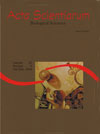<b>Effect of life strategy on the variations of energy content of two fish species (<em>Brycon hilarii e Hypophthalmus edentatus</em>) during their reproductive cycle</b> - DOI: 10.4025/actascibiolsci.v29i2.521
Abstract
The aim of this work was to investigate differences in the energy content during reproductive cycle of two species of fish with different life strategies: Brycon hilarii (k-strategist) and Hypophthalmus edentatus (r-strategist). Fifty-four samples of B. hilarii and 82 of H. edentatus monthly collected from October, 2000 to March, 2004, in Manso reservoir and its influence area were selected. The caloric content was determined for each individual, in kcal g-1 of dry weight, through bomb calorimetry (Parr 1261). Comparisons among the obtained caloric values, the condition factor (K) and the Gonado Somatic Relation were reported. It was observed that, in general, the average values of the K and of the caloric content were higher among males than among females of both species. Significant differences were found in the comparisons accomplished between the energy content and the condition factor on individuals of both species. While B. hilarii presents the highest concentrations of energy in the muscles, during the maximum gonadal development, H. edentatus showed these values in the beginning of gonadal maturation. B. hilarii and H. edentatus, with different life strategies, build up and mobilize energy in different ways during reproductive cycle.Downloads
Download data is not yet available.
Published
2007-12-05
How to Cite
Monteiro, V., Benedito, E., & Domingues, W. M. (2007). <b>Effect of life strategy on the variations of energy content of two fish species (<em>Brycon hilarii e Hypophthalmus edentatus</em>) during their reproductive cycle</b> - DOI: 10.4025/actascibiolsci.v29i2.521. Acta Scientiarum. Biological Sciences, 29(2), 151-159. https://doi.org/10.4025/actascibiolsci.v29i2.521
Issue
Section
Ecology and Limnology
DECLARATION OF ORIGINALITY AND COPYRIGHTS
I Declare that current article is original and has not been submitted for publication, in part or in whole, to any other national or international journal.
The copyrights belong exclusively to the authors. Published content is licensed under Creative Commons Attribution 4.0 (CC BY 4.0) guidelines, which allows sharing (copy and distribution of the material in any medium or format) and adaptation (remix, transform, and build upon the material) for any purpose, even commercially, under the terms of attribution.
Read this link for further information on how to use CC BY 4.0 properly.
0.6
2019CiteScore
31st percentile
Powered by 

0.6
2019CiteScore
31st percentile
Powered by 











1.png)




3.png)













